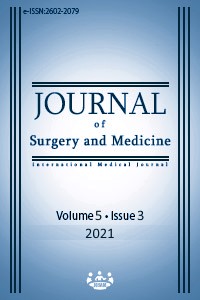Examination of craniofacial parameters in Turkish males with golden ratio in piriform aperture size
Keywords:
Golden ratio, Piriform aperture, Facial aesthetics, Craniofacial parameters, Young adult Turkish malesAbstract
Background/Aim: Piriform aperture, an anatomical structure usually in the form of a pear, is created by the maxilla and nasal bone. The shape and width of PA have significant effects on nasal breathing and are also aesthetically important. In the present study, it was aimed to reveal normal morphometric values by evaluating the craniofacial parameters of young Turkish male cases at the piriform aperture with the help of computerized tomography. Methods: A total of six craniofacial parameters were examined from the 3-dimensional computerized tomography reconstruction images of 103 young adult male cases with golden ratios between the ages of 21 and 30 years. Three indices were calculated from these craniofacial parameters and nine parameters were evaluated. The cases were divided into four groups according to the ratio of the piriform aperture. The descriptive values for the data obtained from craniofacial parameters and indices were calculated as mean and standard deviation. In terms of measurements, the differences between the groups were examined with ANOVA analysis. Results: In our study, there were five cases in the 1st group, 39 cases in the 2nd group, 38 cases in the 3rd group, and 19 cases in the 4th group. Two cases were not included in any of the groups. Significant differences were detected between the groups in terms of maximum cranial width, bizygomatic width, nasal width and upper face index parameters (P<0.05). Conclusion: Differences were detected between the groups in which craniofacial parameters of all male cases were examined. In the inter-group examination, the craniofacial parameters of only a few cases fit the golden ratio fully. For this reason, we recommend examining the identifying values of the craniofacial parameters of more faces on which the piriform aperture is fully compatible with the golden ratio.
Downloads
References
de Araújo TMS, da Silva CJT, de Medeiros LKN, Estrela Y da CA, Silva N de A, Gomes FB, et al. Morphometric analysis of piriform aperture in human skulls. Int J Morphol. 2018;36:483–7. doi: 10.4067/S0717-95022018000200483.
Hommerich CP, Riegel A. Measuring of the piriform aperture in humans with 3D-SSD-CT-reconstructions. Ann Anat. 2002;184:455–9. doi: 10.1016/S0940-9602(02)80078-4.
Moreddu E, Puymerail L, Michel J, Achache M, Dessi P, Adalian P. Morphometric measurements and sexual dimorphism of the piriform aperture in adults. Surg Radiol Anat. 2013;35:917–24. doi: 10.1007/s00276-013-1116-2.
Asghar A, Dixit A, Rani M. Morphometric study of nasal bone and piriform aperture in human dry skull of Indian origin. J Clin Diagnostic Res. 2016;10:AC05–7. doi: 10.7860/JCDR/2016/15677.7148.
McDowell JL, L’Abbé EN, Kenyhercz MW. Nasal aperture shape evaluation between black and white South Africans. Forensic Sci Int. 2012;222:397.e1-397.e6. doi: 10.1016/j.forsciint.2012.06.007.
Sertel Meyvaci S, Kosif R, Bamaç B, Hizal M, Ankarali H. Evaluation of apertura piriformis and related cranial anatomical structures through computed tomography: Golden ratio. Folia Morphol. 2019;78:839–46. doi: 10.5603/FM.a2019.0021.
Kabakci AG, Polat S, Öksüzler M, Öksüzler FY, Yücel AH. The determination of the piriform aperture morphometry and golden ratio in healthy Turkish subjects. A CT study. Int J Morphol. 2020;38:444–7. doi: 10.4067/S0717-95022020000200444.
Prokopakis EP, Vlastos IM, Picavet V, Trenité GN, Thomas R, Cingi C, et al. The golden ratio in facial symmetry. Rhinology 2013;51:18–21. doi: 10.4193/Rhino12.111.
Williams K. Bülent Atalay: Math and the Mona Lisa. Nexus Netw J. 2005;7:113–5. doi: 10.1007/s00004-005-0027-x.
Hicks KE, Thomas JR. The Changing Face of Beauty: A Global Assessment of Facial Beauty. Otolaryngol Clin North Am. 2020;53:185–94. doi: 10.1016/j.otc.2019.12.005.
Jeon A, Sung KH, Kim SD, Lee UY, Lee JH, Han SH, et al. Anatomical changes in the East Asian midface skeleton with aging. Folia Morphol. 2017;76:730–5. doi: 10.5603/FM.a2017.0027.
Key PJ. Craniometric Relationships Among Plains Indians 1983;T2-A2:1-189 PB-University.
Kranioti EF, Işcan MY, Michalodimitrakis M. Craniometric analysis of the modern Cretan population. Forensic Sci Int. 2008;180:110.e1-110.e5. doi: 10.1016/j.forsciint.2008.06.018.
Studies BC. Development and Comparison of Anthropometric Ratios 2012;23:75–83. doi: 10.1097/SCS.0b013e3182468612.
Ekizoglu O, Hocaoglu E, Inci E, Can IO, Solmaz D, Aksoy S, et al. Assessment of sex in a modern Turkish population using cranial anthropometric parameters. Leg Med. 2016;21:45–52. doi: 10.1016/j.legalmed.2016.06.001.
Yüzbasioglu N, Yilmaz MT, Çicekcibasi AE, Seker M, Sakarya ME. The evaluation of morphometry of nasal bone and pyriform aperture using multidetector computed tomography. J Craniofac Surg. 2014;25:2214–9. doi: 10.1097/SCS.0000000000001063.
Abdelaleem SA, Younis RHA, Kader MA. Sex determination from the piriform aperture using multi slice computed tomography: Discriminant function analysis of Egyptian population in Minia Governorate. Egypt J Forensic Sci. 2016;6:429–34. doi: 10.1016/j.ejfs.2016.11.003.
Karadag D, Ozdol NC, Beriat K, Akinci T. CT evaluation of the bony nasal pyramid dimensions in Anatolian people. Dentomaxillofacial Radiol. 2011;40:160–4. doi: 10.1259/dmfr/35578628.
Zamani Naser A, Panahi Boroujeni M. CBCT Evaluation of Bony Nasal Pyramid Dimensions in Iranian Population: A Comparative Study with Ethnic Groups. Int Sch Res. Not 2015;1–5. doi: 10.1155/2014/819378.
Sexual D, Lineales D, Alejandra D, Matamala Z. Sexual Dimorphism Determination From The Lineal Dimensions of Skulls. Int J Morphol. 2009;27(1):133-7.
Downloads
- 190 410
Published
Issue
Section
How to Cite
License
Copyright (c) 2021 Seda Sertel Meyvacı, Mustafa Hızal, Handan Ankaralı
This work is licensed under a Creative Commons Attribution-NonCommercial-NoDerivatives 4.0 International License.
















